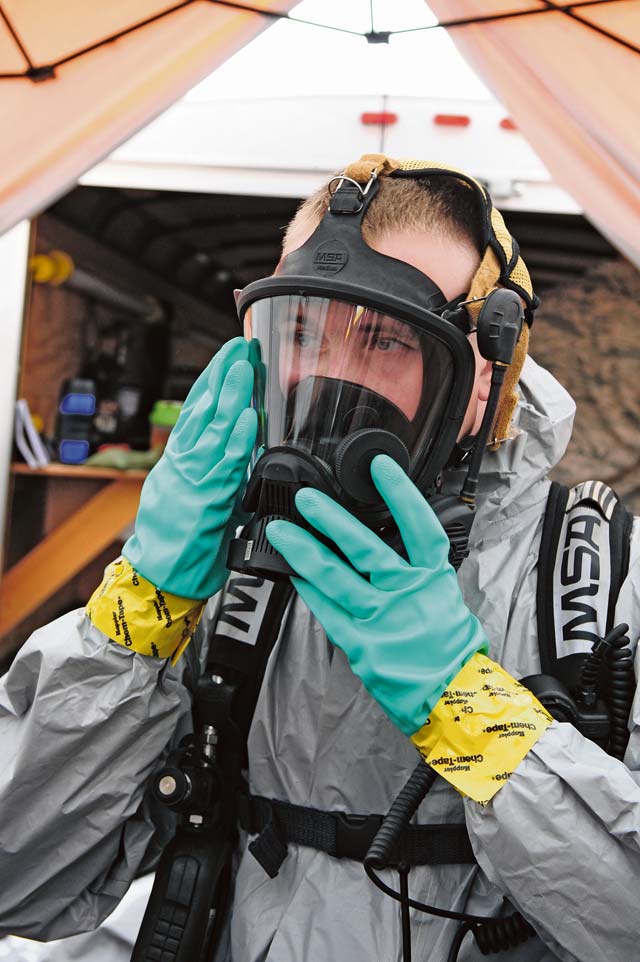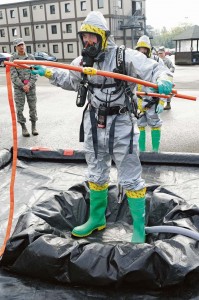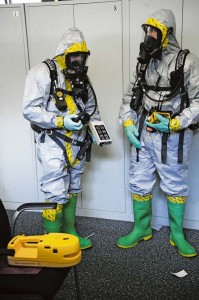
Airmen from the 786th Civil Engineer Squadron Emergency Management Flight have an important role to play in keeping the KMC safe.
Imagine what things would be like if there wasn’t someone who knew how to tell which chemicals were
bad and which ones were deadly.
“The primary mission of the Ramstein EM program is to save lives,” said Master Sgt. Jocelin Borisow, 786th CES EM superintendent. “We minimize the loss or degradation of resources and continue, sustain and restore operational capability in all hazards that are a threat to the environment within the KMC.”
Through training, planning and a thorough technical school, Airmen from the EM are given the resources to get the job done.

“Tech school was exciting but nerve-racking,” said Senior Airman Alexy Doran, 786th CES EM specialist. “We were required to demonstrate competence in utilizing our equipment. We were able to play with dangerous chemicals, and once it was over, I felt confident that I could use my equipment, find and mitigate the bad stuff and stay protected during a real-world threat.”
Airmen from the EM flight face many challenges on a daily basis, which are overcome by working together.
“We have a very diverse mission that is often in high demand, but we must also be able to respond to some of the world’s scariest scenarios. Keeping our skills sharp is paramount to effective wartime readiness, and it’s through joint training events that we stay prepared,” said Tech. Sgt. Tyler Seeholzer, 786th CES NCO in charge of EM training. “Our skill sets partner well with those of other career fields, such as bioenvironmental, and we become better responders when we understand the strength and limiting factors of other responders. By training together we better understand our roles and how we support the mission.”
The KMC has a community of more than 57,000 members, which Ramstein’s EM supports and is in charge of ensuring the stability of operations during emergencies for this large area.
“When I originally enlisted, I really wanted to help people,” said Staff Sgt. Kevin Spranger II, 786th CES EM technician. “The job options presented to me were firefighter, security forces and EM. The job description for EM referenced attack preparations and post-attack actions, and I really liked the idea of helping service members recover from chemical, biological, radiological and nuclear attacks.”

Being part of EM affects everyone in the Air Force and is closely related to many things on the outside.
“Aside from nation-ally recognized hazardous materials certifications, our job offers the ability to have a base-wide affect right out of tech school,” Seeholzer said. “Our Airmen train everyone on base right up to the commanders and often brief operational capabilities to senior leaders. In the civilian sector, we line
up quite well with the Federal Emergency Management Agency state and local emergency response agencies.”
September was National Prepared-ness Month, and Airmen from the EM community are trying to stress to people that they should be attentive.
“We encourage all service members to remain vigilant and ensure the readiness of their work centers and their families,” Seeholzer said. “The four-step mantra best sums up our message for everyone: stay informed, make a plan, build a kit and get involved. Our office stands ready to help anyone in this endeavor, as does our website, beready.af.mil. There is even a ‘Be Ready’ app for that!”







